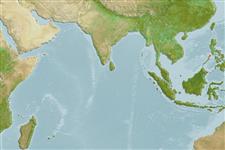Classification / Names
Common names from other countries
Référence principale
Taille / Poids / Âge
Max length : 6.8 cm SL mâle / non sexé; (Ref. 89094)
Environnement
; marin récifal; profondeur 0 - 40 m (Ref. 89094), usually 0 - 20 m (Ref. 89094)
Climat / Gamme
Tropical, preferred ?; 12°N - 11°N, 119°E - 120°E
Distribution
Description synthétique
Épines dorsales (Total): 3; Rayons mous dorsaux (Total): 24; Épines anales 3; Rayons mous anaux: 14. This species differs from other pseudochromids in having the following set of characters: D III,24; A III,14; pelvic-fin rays I,5; anterior tip of palatine tooth patch directed medially behind posterolateral arm of vomerine tooth patch; upper part of body with dark (dark grey to black in life) longitudinal stripe, extending horizontally to or towards caudal-fin base; scales in lateral series 41-45; circumpeduncular scales 22-23 (Ref. 89094).
Statut dans la liste rouge de l'IUCN (Ref. 115185)
Menace pour l'homme
Harmless
Utilisations par l'homme
Plus d'informations
Noms communsSynonymesMétabolismePrédateursÉcotoxicologieReproductionMaturitéFraiFéconditéŒufsDéveloppement de l'œuf
Taille/ÂgeCroissanceLongueur-poidsLongueur-longueurFréquences de longueursMorphométrieMorphologieLarvesDynamique des populations larvairesRecrutementAbondance
RéférencesAquacultureProfil d'aquacultureSouchesGénétiqueFréquences alléliquesHéritabilitéPathologiesTraitementMass conversion
CollaborateursImagesStamps, CoinsSonsCiguateraVitesseType de nageSurface branchialeOtolithesCerveauxVision
Outils
Articles particuliers
Télécharger en XML
Sources Internet
Estimates of some properties based on models
Phylogenetic diversity index
PD50 = 0.5000 many relatives (e.g. carps) 0.5 - 2.0 few relatives (e.g. lungfishes)
Niveau trophique
3.5 ±0.5 se; Based on size and trophs of closest relatives
Résilience
Haut, temps minimum de doublement de population inférieur à 15 mois ()
Vulnérabilité
Low vulnerability (10 of 100)
Catégorie de prix
